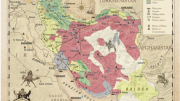Last week, the Royal Saudi Air Force released black-and-white aerial footage that shows two cars hurtling down an unidentified street. One vehicle turns right and pauses, waiting, it seems, for the second to catch up. As the tailing car arrives, the camera zooms. Moments later, the lead car is engulfed in flame and billowing black smoke. The doors of the second car open, and four figures exit and start to dash forward. A voice offscreen reads out coördinates in English. A wall of flame engulfs the four. The control room erupts into claps. “Yes! Yes!” a voice shouts in accented English. “Thank you! Good hit. Super!”
The tapes, shot on April 19th, are rare footage of what Saudi Arabia claims are air strikes carried out as part of its war on Houthi rebels in Yemen. Days after the video’s release, Houthi leaders announced that the strike had killed Saleh al-Sammad, the leader of its Supreme Political Council. Since March, 2015, Riyadh has led a coalition of nine Arab and African countries attacking the Houthis in Yemen. The United States and United Kingdom are providing the Saudi-led coalition with targeting tools, logistical support, and weaponry. About fifty U.S. military advisers are in Saudi Arabia helping with the effort. A Pentagon spokesman said that American military forces did not participate in the strike shown in the videos.
Sammad’s death comes amid rising tensions between Washington and Tehran as President Trump plans to announce whether the U.S. will withdraw from the Iran nuclear agreement on May 12th. The war in Yemen, a proxy battle between the U.S. and Saudi Arabia on one side and Iran on the other, has sparked what the U.N. calls the world’s worst humanitarian crisis. A former teacher, Sammad was the most important civilian leader in the Houthi movement. The Saudis put him in second place on their most-wanted list, offering twenty million dollars for his capture. He was seen as a relatively moderate force in the Houthi high command, and reportedly supported the secret peace talks that the Houthis have been conducting with the Saudis in Oman. But he was also known for his extreme rhetoric: a few weeks before his death, he threatened additional Houthi ballistic-missile attacks on Saudi territory.
On Sunday, Mike Pompeo, President Trump’s new Secretary of State, was in Saudi Arabia for talks with the Saudi foreign minister. Pompeo reaffirmed the U.S. policy that “a political solution is the only way to advance long-term stability in Yemen and end the suffering,” and that groups such as Al Qaeda and the Islamic State’s local affiliates have flourished in the vacuum created by the war. But Pompeo blamed Iran for supplying the Houthis with weapons.
On Twitter, members of the Saudi royal family celebrated Sammad’s killing and touted it as a success for the country’s crown prince and de-facto ruler, Mohammed bin Salman, who recently toured Washington and Los Angeles to curry support from the Trump Administration. But the effect of the strike might be to push the Houthis further from the negotiating table. Sammad’s replacement, Mahdi al-Mashat, a politician in his thirties, has demanded all-out war with Saudi Arabia. Peter Salisbury, a senior analyst at Chatham House, said that the strike would reduce the interest of the group’s over-all leader, Abdelmalik al-Houthi, in peace talks. “What it does do is take someone who thought dealmaking was a way of ending the war and replace him with someone more bellicose,” Salisbury told me. “You get into a position where all the voices that Abdulmalik hears are all the hard-liners, the people who are benefitting the most from the war.”
Shireen al-Adeimi, a Yemeni analyst and doctoral student at Harvard, said that the strike sent the wrong message. “It’s an assassination,” she said. “Any group that assassinates political leaders gives a strong message that they don’t want peace talks. Imagine if the Houthis had sent missiles to Saudi that killed Mohammed bin Salman.”
U.S. officials have told me that when the bombing began, three years ago, the Saudis claimed that it would force the Houthis to the negotiating table in six weeks. But, as the campaign has dragged on, it has had the opposite effect, forcing the Houthis to retrench, empowering terrorist groups linked with Al Qaeda in the south, and fomenting widespread resentment in Yemen against the coalition and its Western partners. At least ten thousand civilians have been killed in the strikes, and eight million people are now on the edge of famine.
The Saudi-led strikes have often hit civilian targets, despite the level of precision shown in the Sammad video. On the same day that the Houthis confirmed Sammad’s death, last week, news emerged that the coalition had bombed a wedding in the northern province of Hajjah, killing at least fifty civilians, mainly women and children. The coalition said that it was “investigating” the Hajjah attack. While videos of Sammad’s demise were released, the coalition declined to say which nation was responsible for the Hajjah strike.
Source: www.newyorker.com



Be the first to comment at "A Saudi-Backed “Assassination” Could Worsen Yemen’s War"